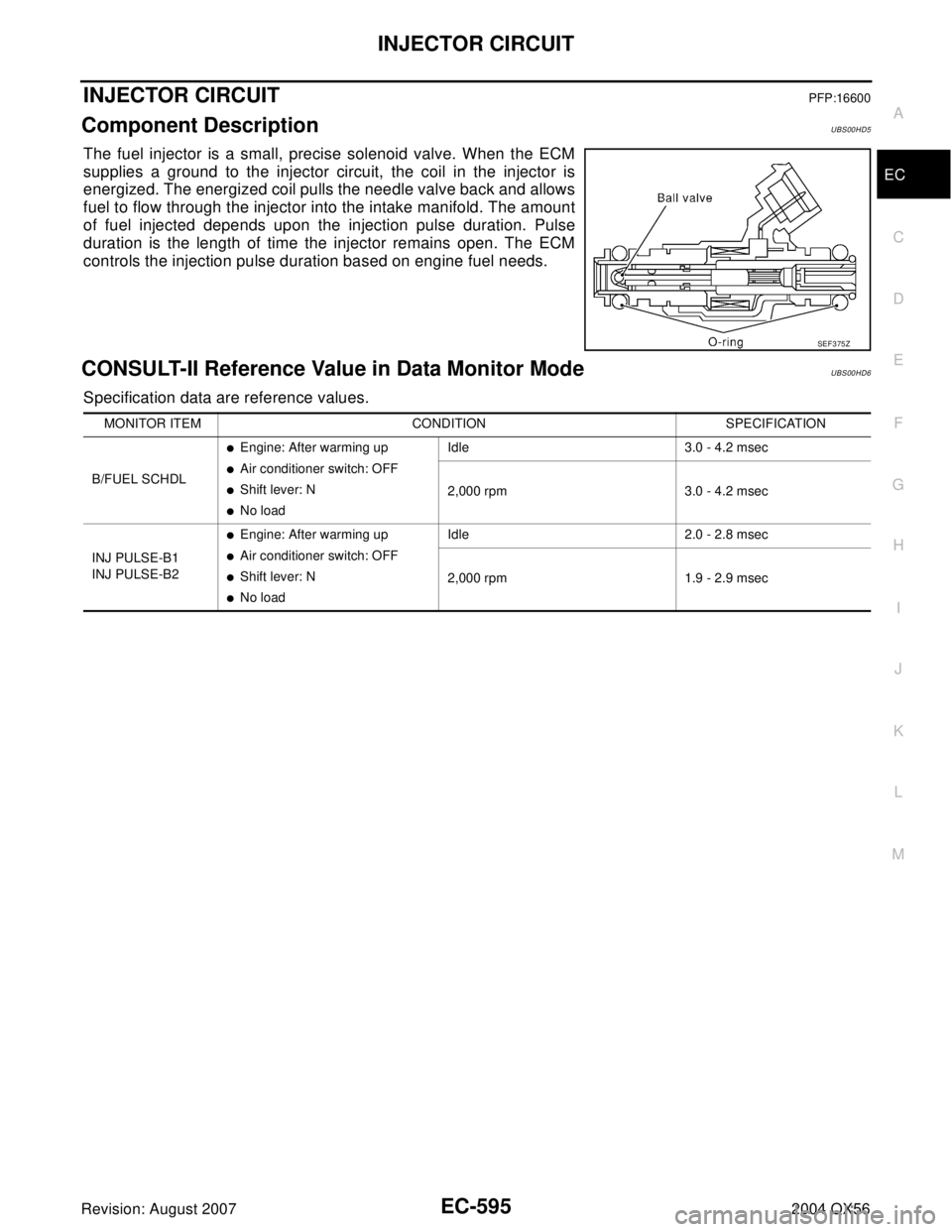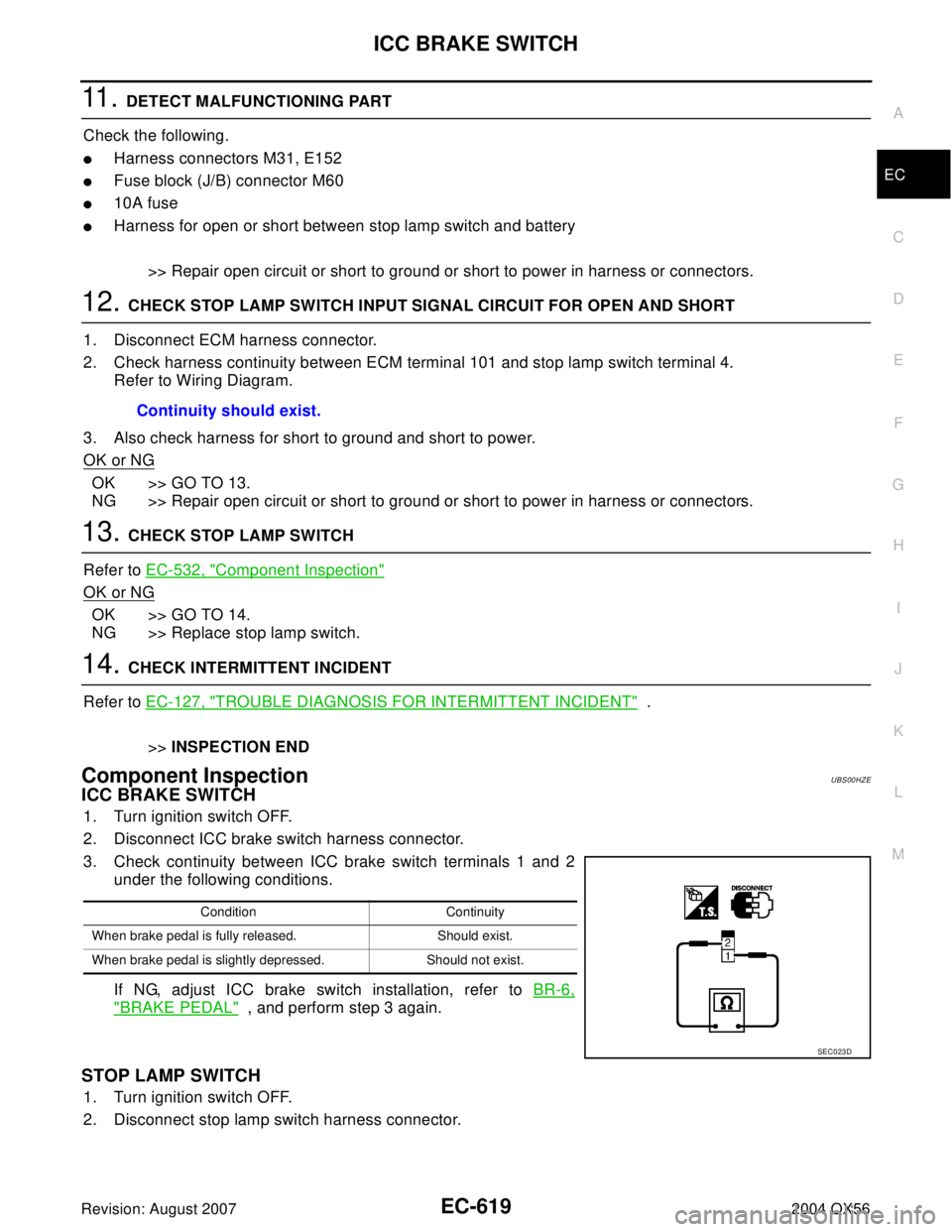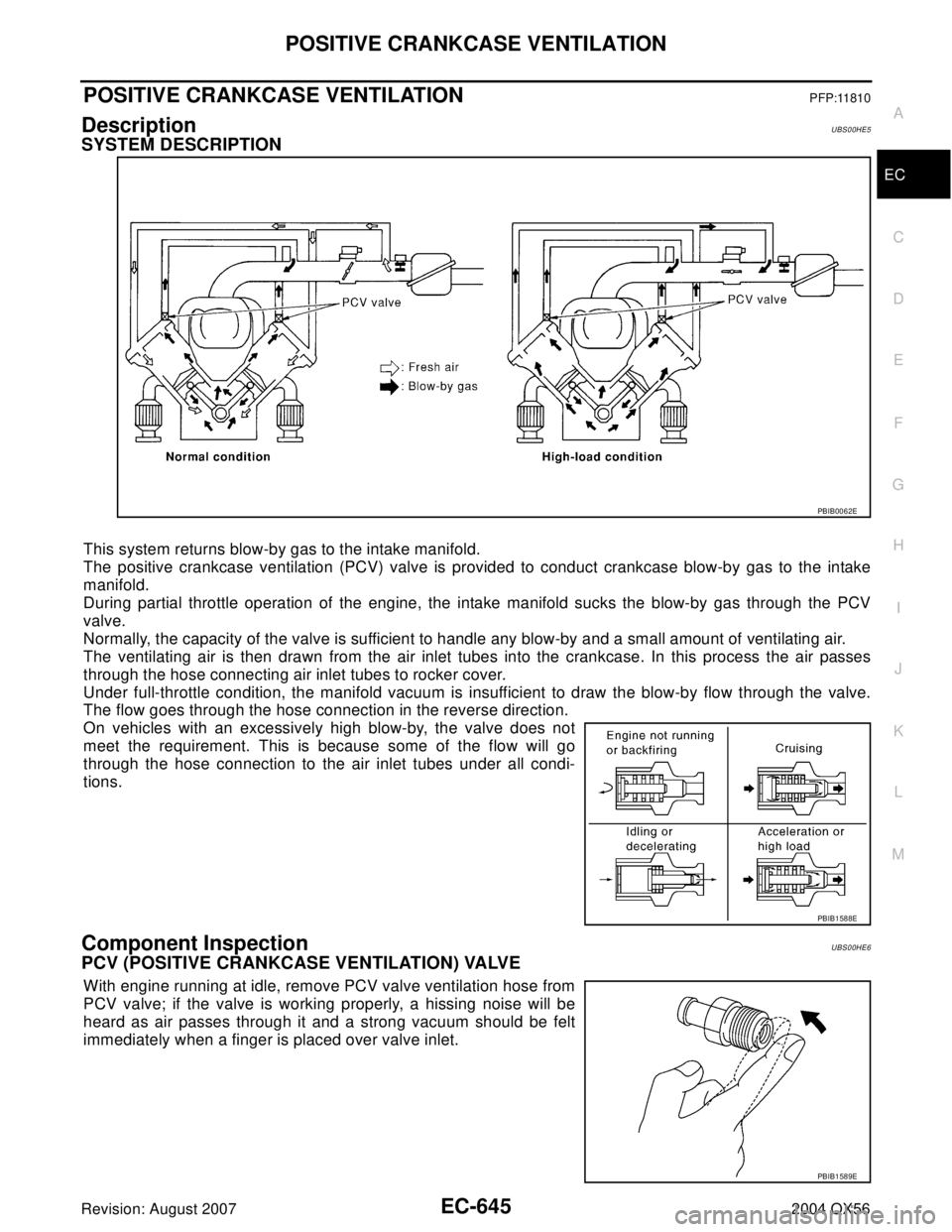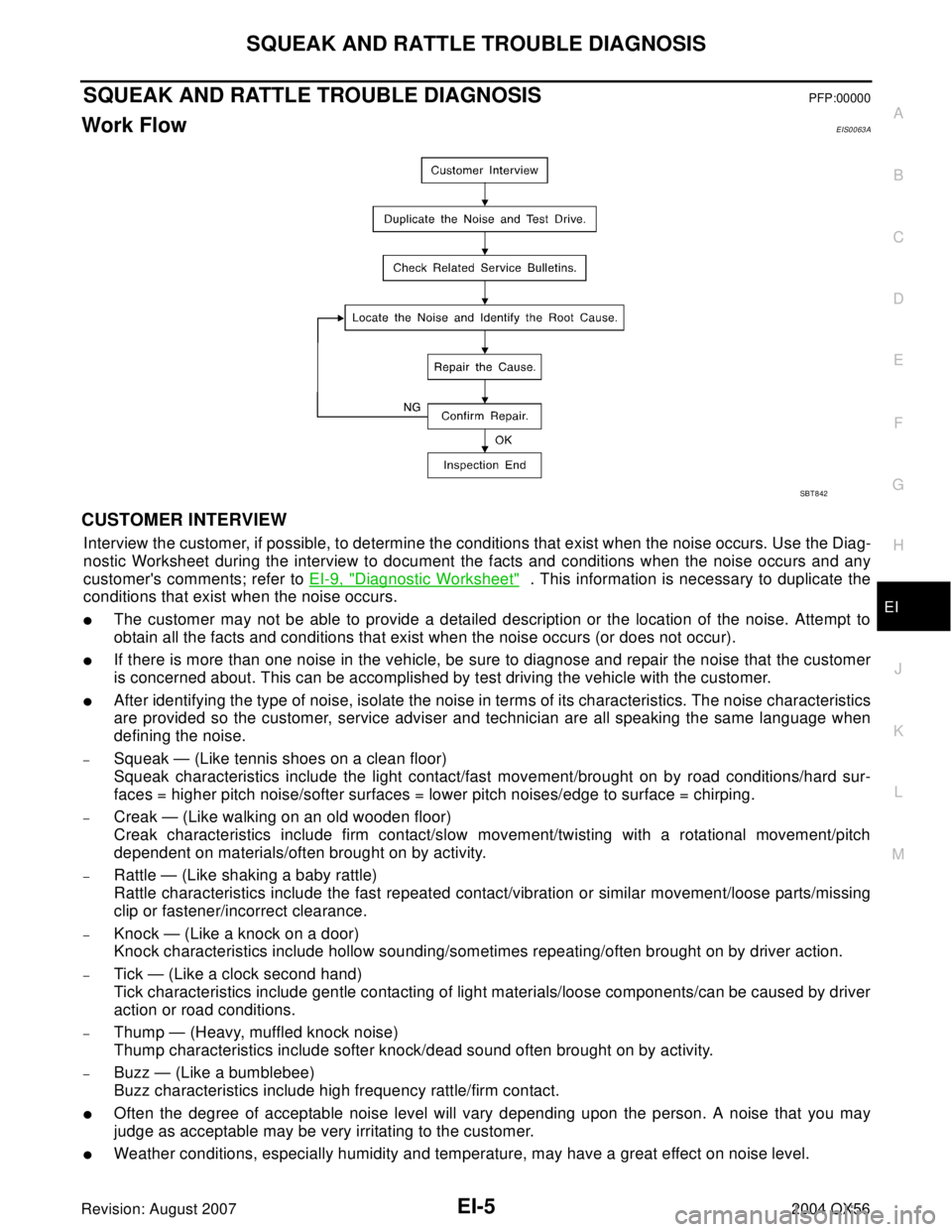Page 1773 of 3371
EC-582Revision: August 2007
DTC P2138 APP SENSOR
2004 QX56
Component InspectionUBS00HCY
ACCELERATOR PEDAL POSITION SENSOR
1. Reconnect all harness connectors disconnected.
2. Turn ignition switch ON.
3. Check voltage between ECM terminals 106 (APP sensor 1 sig-
nal), 98 (APP sensor 2 signal) and ground under the following
conditions.
4. If NG, replace accelerator pedal assembly and go to next step.
5. Perform EC-44, "
Accelerator Pedal Released Position Learning" .
6. Perform EC-44, "
Throttle Valve Closed Position Learning" .
7. Perform EC-44, "
Idle Air Volume Learning" .
Removal and InstallationUBS00HCZ
ACCELERATOR PEDAL
Refer to ACC-2, "ACCELERATOR CONTROL SYSTEM" .
Terminal Accelerator pedal Voltage
106
(Accelerator pedal position
sensor 1)Fully released 0.5 - 1.0V
Fully depressed 4.2 - 4.8V
98
(Accelerator pedal position
sensor 2)Fully released 0.25 - 0.5V
Fully depressed 2.0 - 2.5V
MBIB0023E
Page 1786 of 3371

INJECTOR CIRCUIT
EC-595
C
D
E
F
G
H
I
J
K
L
MA
EC
Revision: August 20072004 QX56
INJECTOR CIRCUITPFP:16600
Component DescriptionUBS00HD5
The fuel injector is a small, precise solenoid valve. When the ECM
supplies a ground to the injector circuit, the coil in the injector is
energized. The energized coil pulls the needle valve back and allows
fuel to flow through the injector into the intake manifold. The amount
of fuel injected depends upon the injection pulse duration. Pulse
duration is the length of time the injector remains open. The ECM
controls the injection pulse duration based on engine fuel needs.
CONSULT-II Reference Value in Data Monitor ModeUBS00HD6
Specification data are reference values.
SEF 3 75 Z
MONITOR ITEM CONDITION SPECIFICATION
B/FUEL SCHDL
�Engine: After warming up
�Air conditioner switch: OFF
�Shift lever: N
�No loadIdle 3.0 - 4.2 msec
2,000 rpm 3.0 - 4.2 msec
INJ PULSE-B1
INJ PULSE-B2
�Engine: After warming up
�Air conditioner switch: OFF
�Shift lever: N
�No loadIdle 2.0 - 2.8 msec
2,000 rpm 1.9 - 2.9 msec
Page 1798 of 3371
REFRIGERANT PRESSURE SENSOR
EC-607
C
D
E
F
G
H
I
J
K
L
MA
EC
Revision: August 20072004 QX56
REFRIGERANT PRESSURE SENSORPFP:92136
Component DescriptionUBS00HDH
The refrigerant pressure sensor is installed at the liquid tank of the
air conditioner system. The sensor uses an electrostatic volume
pressure transducer to convert refrigerant pressure to voltage. The
voltage signal is sent to ECM, and ECM controls cooling fan system.
BBIA0445E
SEF 0 99 XA
Page 1807 of 3371
EC-616Revision: August 2007
ICC BRAKE SWITCH
2004 QX56
2. CHECK OVERALL FUNCTION-II
With CONSULT-II
Check “BRAKE SW2” indication in “DATA MONITOR” mode.
Without CONSULT-II
Check voltage between ECM terminal 101 and ground under the fol-
lowing conditions.
OK or NG
OK >>INSPECTION END
NG >> GO TO 10.
3. CHECK DTC WITH ICC UNIT
Refer to ACS-26, "
TROUBLE DIAGNOSIS — GENERAL DESCRIPTION" .
OK or NG
OK >> GO TO 4.
NG >> Repair or replace.
CONDITION INDICATION
When brake pedal is fully released OFF
When brake pedal is slightly depressed ON
SEC0 13 D
CONDITION VOLTAGE
When brake pedal is fully released Approximately 0V
When brake pedal is slightly depressed Battery voltage
MBIB0060E
Page 1810 of 3371

ICC BRAKE SWITCH
EC-619
C
D
E
F
G
H
I
J
K
L
MA
EC
Revision: August 20072004 QX56
11 . DETECT MALFUNCTIONING PART
Check the following.
�Harness connectors M31, E152
�Fuse block (J/B) connector M60
�10A fuse
�Harness for open or short between stop lamp switch and battery
>> Repair open circuit or short to ground or short to power in harness or connectors.
12. CHECK STOP LAMP SWITCH INPUT SIGNAL CIRCUIT FOR OPEN AND SHORT
1. Disconnect ECM harness connector.
2. Check harness continuity between ECM terminal 101 and stop lamp switch terminal 4.
Refer to Wiring Diagram.
3. Also check harness for short to ground and short to power.
OK or NG
OK >> GO TO 13.
NG >> Repair open circuit or short to ground or short to power in harness or connectors.
13. CHECK STOP LAMP SWITCH
Refer to EC-532, "
Component Inspection"
OK or NG
OK >> GO TO 14.
NG >> Replace stop lamp switch.
14. CHECK INTERMITTENT INCIDENT
Refer to EC-127, "
TROUBLE DIAGNOSIS FOR INTERMITTENT INCIDENT" .
>>INSPECTION END
Component InspectionUBS00HZE
ICC BRAKE SWITCH
1. Turn ignition switch OFF.
2. Disconnect ICC brake switch harness connector.
3. Check continuity between ICC brake switch terminals 1 and 2
under the following conditions.
If NG, adjust ICC brake switch installation, refer to BR-6,
"BRAKE PEDAL" , and perform step 3 again.
STOP LAMP SWITCH
1. Turn ignition switch OFF.
2. Disconnect stop lamp switch harness connector.Continuity should exist.
Condition Continuity
When brake pedal is fully released. Should exist.
When brake pedal is slightly depressed. Should not exist.
SEC0 23 D
Page 1836 of 3371

POSITIVE CRANKCASE VENTILATION
EC-645
C
D
E
F
G
H
I
J
K
L
MA
EC
Revision: August 20072004 QX56
POSITIVE CRANKCASE VENTILATIONPFP:11810
DescriptionUBS00HE5
SYSTEM DESCRIPTION
This system returns blow-by gas to the intake manifold.
The positive crankcase ventilation (PCV) valve is provided to conduct crankcase blow-by gas to the intake
manifold.
During partial throttle operation of the engine, the intake manifold sucks the blow-by gas through the PCV
valve.
Normally, the capacity of the valve is sufficient to handle any blow-by and a small amount of ventilating air.
The ventilating air is then drawn from the air inlet tubes into the crankcase. In this process the air passes
through the hose connecting air inlet tubes to rocker cover.
Under full-throttle condition, the manifold vacuum is insufficient to draw the blow-by flow through the valve.
The flow goes through the hose connection in the reverse direction.
On vehicles with an excessively high blow-by, the valve does not
meet the requirement. This is because some of the flow will go
through the hose connection to the air inlet tubes under all condi-
tions.
Component InspectionUBS00HE6
PCV (POSITIVE CRANKCASE VENTILATION) VALVE
With engine running at idle, remove PCV valve ventilation hose from
PCV valve; if the valve is working properly, a hissing noise will be
heard as air passes through it and a strong vacuum should be felt
immediately when a finger is placed over valve inlet.
PBIB0062E
PBIB1588E
PBIB1589E
Page 1840 of 3371

SERVICE DATA AND SPECIFICATIONS (SDS)
EC-649
C
D
E
F
G
H
I
J
K
L
MA
EC
Revision: August 20072004 QX56
SERVICE DATA AND SPECIFICATIONS (SDS)PFP:00030
Fuel PressureUBS00HE9
Idle Speed and Ignition TimingUBS00HEA
*1: Under the following conditions:
�Air conditioner switch: OFF
�Electric load: OFF (Lights and heater fan)
�Steering wheel: Kept in straight-ahead position
Calculated Load ValueUBS00HEB
Mass Air Flow SensorUBS00HEC
*: Engine is warmed up to normal operating temperature and running under no-load.
Intake Air Temperature SensorUBS00HED
Engine Coolant Temperature SensorUBS00HEE
A/F Sensor 1 HeaterUBS00HEF
Heated Oxygen sensor 2 HeaterUBS00HEG
Crankshaft Position Sensor (POS)UBS00HEH
Refer to EC-260, "Component Inspection" .
Camshaft Position Sensor (PHASE)UBS00HEI
Refer to EC-266, "Component Inspection" .
Throttle Control MotorUBS00HEJ
Fuel pressure at idling kPa (kg/cm2 , psi)Approximately 350 (3.57, 51)
Target idle speed
No-load*1 (in P or N position)650±50 rpm
Air conditioner: ON In P or N position 700 rpm or more
Ignition timing In P or N position 15° ± 5° BTDC
Condition Calculated load value % (Using CONSULT-II or GST)
At idle14.0 - 33.0
At 2,500 rpm12.0 - 25.0
Supply voltage Battery voltage (11 - 14V)
Output voltage at idle1.1 - 1.4V*
Mass air flow (Using CONSULT-II or GST)3.0 - 9.0 g·m/sec at idle*
9.0 - 28.0 g·m/sec at 2,500 rpm*
Temperature °C (°F) Resistance kΩ
25 (77)1.9 - 2.1
80 (176)0.31 - 0.37
Temperature °C (°F) Resistance kΩ
20 (68)2.1 - 2.9
50 (122)0.68 - 1.00
90 (194)0.236 - 0.260
Resistance [at 25°C (77°F)] 3.3 - 4.3Ω
Resistance [at 25°C (77°F)] 5.0 - 7.0Ω
Resistance [at 25°C (77°F)] Approximately 1 - 15Ω
Page 1846 of 3371

SQUEAK AND RATTLE TROUBLE DIAGNOSIS
EI-5
C
D
E
F
G
H
J
K
L
MA
B
EI
Revision: August 20072004 QX56
SQUEAK AND RATTLE TROUBLE DIAGNOSISPFP:00000
Work FlowEIS0063A
CUSTOMER INTERVIEW
Interview the customer, if possible, to determine the conditions that exist when the noise occurs. Use the Diag-
nostic Worksheet during the interview to document the facts and conditions when the noise occurs and any
customer's comments; refer to EI-9, "
Diagnostic Worksheet" . This information is necessary to duplicate the
conditions that exist when the noise occurs.
�The customer may not be able to provide a detailed description or the location of the noise. Attempt to
obtain all the facts and conditions that exist when the noise occurs (or does not occur).
�If there is more than one noise in the vehicle, be sure to diagnose and repair the noise that the customer
is concerned about. This can be accomplished by test driving the vehicle with the customer.
�After identifying the type of noise, isolate the noise in terms of its characteristics. The noise characteristics
are provided so the customer, service adviser and technician are all speaking the same language when
defining the noise.
–Squeak — (Like tennis shoes on a clean floor)
Squeak characteristics include the light contact/fast movement/brought on by road conditions/hard sur-
faces = higher pitch noise/softer surfaces = lower pitch noises/edge to surface = chirping.
–Creak — (Like walking on an old wooden floor)
Creak characteristics include firm contact/slow movement/twisting with a rotational movement/pitch
dependent on materials/often brought on by activity.
–Rattle — (Like shaking a baby rattle)
Rattle characteristics include the fast repeated contact/vibration or similar movement/loose parts/missing
clip or fastener/incorrect clearance.
–Knock — (Like a knock on a door)
Knock characteristics include hollow sounding/sometimes repeating/often brought on by driver action.
–Tick — (Like a clock second hand)
Tick characteristics include gentle contacting of light materials/loose components/can be caused by driver
action or road conditions.
–Thump — (Heavy, muffled knock noise)
Thump characteristics include softer knock/dead sound often brought on by activity.
–Buzz — (Like a bumblebee)
Buzz characteristics include high frequency rattle/firm contact.
�Often the degree of acceptable noise level will vary depending upon the person. A noise that you may
judge as acceptable may be very irritating to the customer.
�Weather conditions, especially humidity and temperature, may have a great effect on noise level.
SBT 8 42